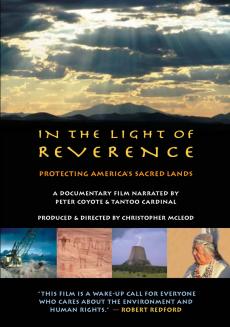In the Light of Reverence facts for kids
Quick facts for kids In the Light of Reverence |
|
|---|---|
 |
|
| Narrated by | Peter Coyote |
| Distributed by | Bullfrog Films, Native American Public Telecommunications |
| Running time | 73 minutes |
| Country | United States |
| Language | English |
In the Light of Reverence is a documentary film from 2001. It was made by Christopher McLeod and Malinda Maynor. This film tells the stories of three Native American groups: the Hopi, the Winnemem Wintu, and the Lakota Sioux.
The film shows how these groups are trying to protect three very important places. These places are sacred, meaning they are holy and special to their beliefs. They are central to how these tribes understand the world. They also show their spiritual duty to care for their homelands.
The three stories in In the Light of Reverence help people understand and talk about these issues. The filmmakers worked with Native American advisors. They built strong relationships over many years to create the film.
The sacred sites are Devils Tower in the Lakota Black Hills, the Four Corners area for the Hopi in Arizona, and Mount Shasta for the Winnemem Wintu. These places are very beautiful. However, they have caused disagreements. Native Americans and non-Native people have different ideas about how to use the land. The Lakota, Hopi, and Winnemem Wintu see these lands as sacred. Other groups, like mining companies, New Age followers, and rock climbers, often see the land as a resource for business or fun.
Contents
Protecting Sacred Places
What is a Sacred Site?
For many Native American tribes, certain places on the land are deeply spiritual. These are called sacred sites. They are like churches or temples for their religion. People go there to pray, hold ceremonies, and connect with their ancestors. Protecting these sites is very important for their way of life and beliefs.
The Film's Stories
In the Light of Reverence focuses on three specific sacred places. Each place is important to a different Native American tribe.
- Devils Tower in Wyoming is sacred to the Lakota Sioux.
- The Four Corners area in Arizona is sacred to the Hopi.
- Mount Shasta in California is sacred to the Winnemem Wintu.
The film shows the challenges these tribes face. They work hard to keep these special places safe from harm.
Why These Places Matter
A Law for Freedom
In 1978, the United States Congress passed a law called the American Indian Religious Freedom Act (AIRFA). This law made Native American worship practices legal again. Before this, many of their traditions had been banned for over 100 years. Native Americans hoped this law would help protect their sacred places. However, they often lost in court when they tried to use AIRFA to protect these sites.
The G-O Road Case
One important case happened in 1988. The Supreme Court made a ruling that affected Native Americans. Lower courts had agreed with Native Americans in northern California. They wanted to stop a logging road from being built through their sacred "high country." This area in the Siskiyou Mountains was used for vision quests and gathering special plants. But the Supreme Court said the road could be built.
This decision caused a big problem for Native American communities. It seemed that laws did not fully protect their sacred sites. Their religious freedom did not extend to protecting the places they needed to worship.
The Devils Tower Debate
In the early 1990s, Native Americans realized something important. Most non-Native people did not understand why sacred places were so important to them. They decided to teach the public about these sites.
A big conflict happened at Devils Tower in Wyoming. This place is sacred to the Lakota. It is also popular for rock climbing. In 1997, a legal fight started. Climbers sued the National Park Service. The Park Service had asked climbers to respect Native American beliefs about the tower.
Christopher McLeod, the film's producer, decided to add the Devils Tower story to the film. He wanted to show a legal conflict over a sacred site. He also pointed out a difference: it is against the law to climb on Mount Rushmore, which is important to European Americans. Yet, climbing was allowed on sacred Native American sites. McLeod and Maynor worked on the film for ten years.
About the Film
Making the Documentary
In the Light of Reverence is narrated by actor Peter Coyote and Tantoo Cardinal. It first showed in San Francisco on February 17, 2001.
Awards and Impact
The film won the Best Documentary Feature Award at the American Indian Film Festival. It was shown on PBS as part of the POV series on August 14, 2001. About three million people watched it. In 2005, the film received the Henry Hampton Award. This award recognized the film's influence and how well it was received by Native American communities.
The film includes interviews with important people. These include Vine Deloria, Jr. of the Standing Rock Sioux, Florence Jones of the Winnemem Wintu, and Charles Wilkinson.

